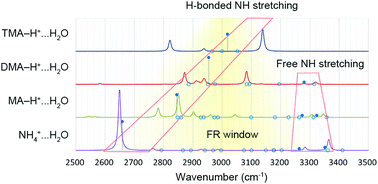Vibrational spectroscopy of protonated amine–water clusters: tuning Fermi resonance and lighting up dark states†
Abstract
Strong coupling between stretching fundamentals and bending overtones of vibrational modes, known as Fermi resonance (FR), has been observed for proton motions in the protonated trimethylamine–water cluster. To investigate the role of FR, we examined the vibrational spectra of other three protonated ammonia/amine–water clusters, including the NH4+ ion and its mono- and di-methylated analogues, respectively, with and without argon tagging. In these systems, a simple frequency-scaled harmonic oscillator model will predict only one strong band between 2600 and 3200 cm−1 uniquely due to the hydrogen-bonded NH stretching fundamental for a given conformer. In the experimental vibrational spectra, however, multiple sharp bands were observed. Such a discrepancy often leads to the notions of the coexistence of multiple conformers and/or the appearance of an overtone state as a result of FR. In this work, we applied a discrete variable representation (DVR) implementation of ab initio anharmonic algorithms and demonstrated how one N–H+ stretching fundamental can lead to multiple bands as a result of intrinsic anharmonic couplings. A prominent effect of tuning these FR bands and lighting up dark overtone states in this wide frequency range was investigated by changing the number of methyl groups in the protonated amine moiety. The effect of Ar-tagging was also analyzed and decent agreement between the experimental and simulated spectra certified the above-mentioned simple pictures. We also found that the coupling constant for trimethylamine is the largest among these protonated amine–water clusters, and the overall coupling strength decreases as the hydrogen-bonded NH stretching frequency redshifts in the order of dimethylamine, methylamine, and ammonia.



 Please wait while we load your content...
Please wait while we load your content...